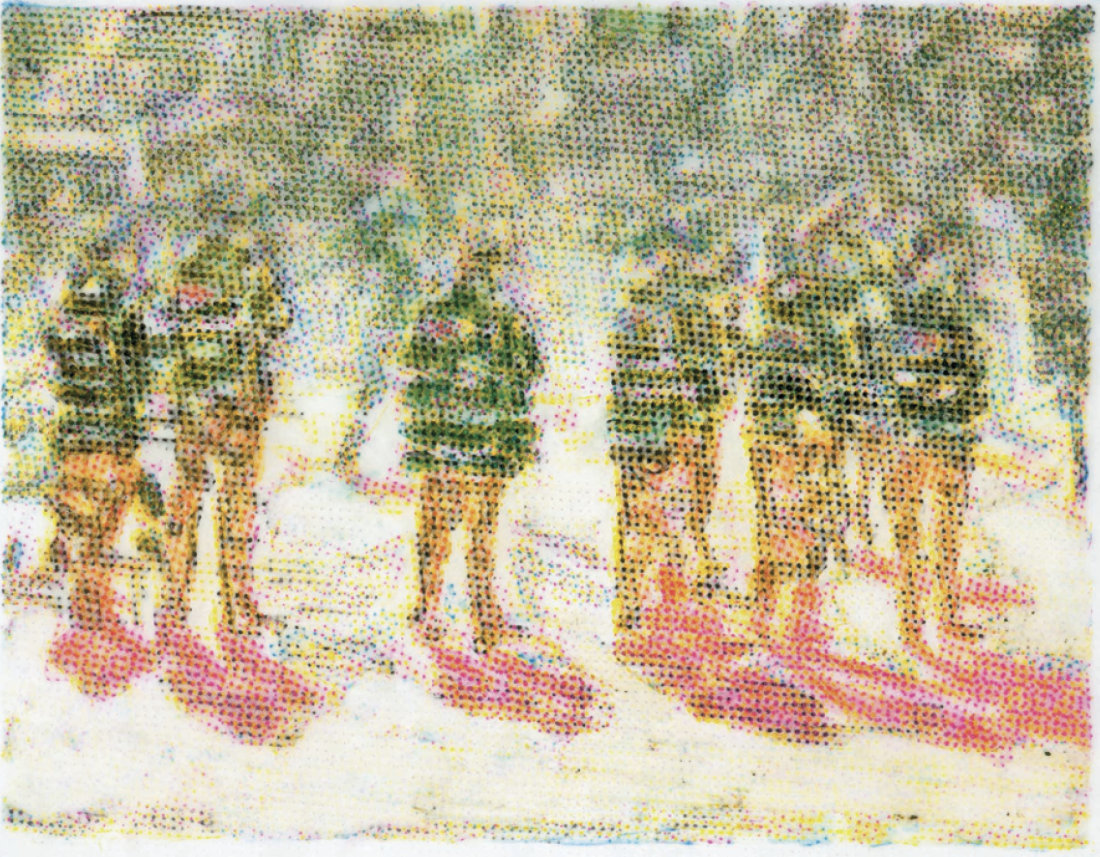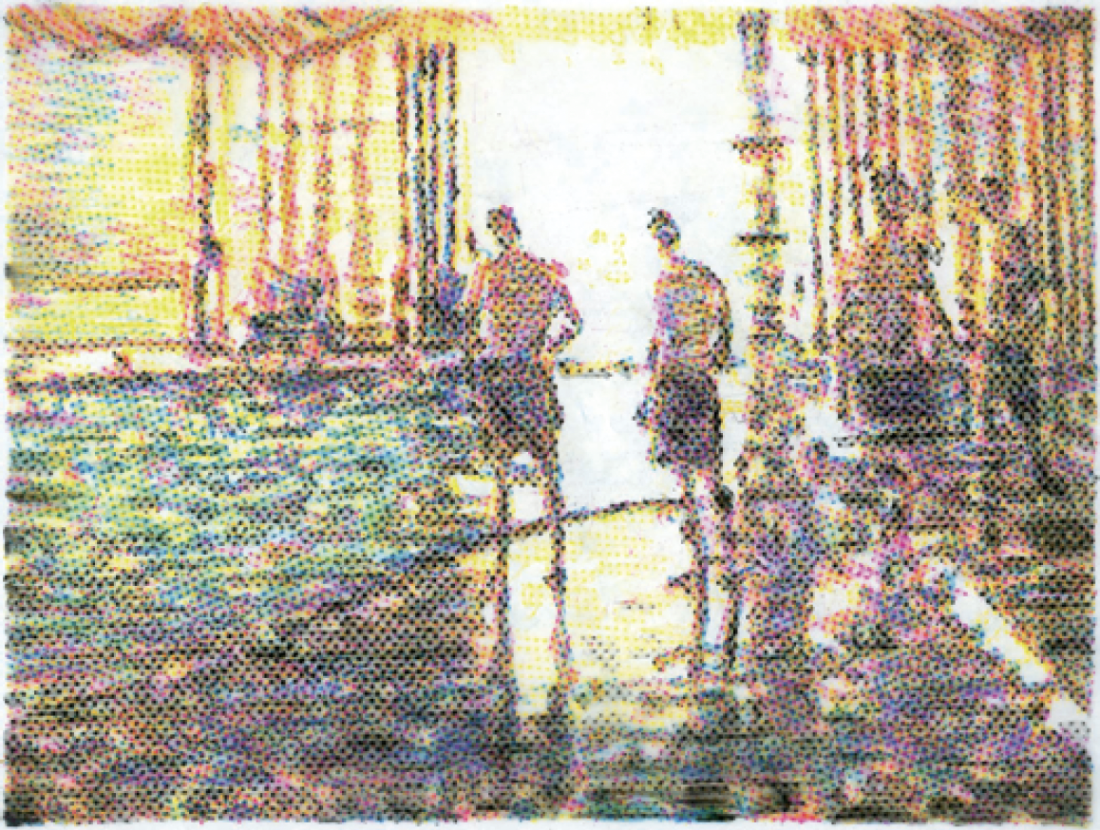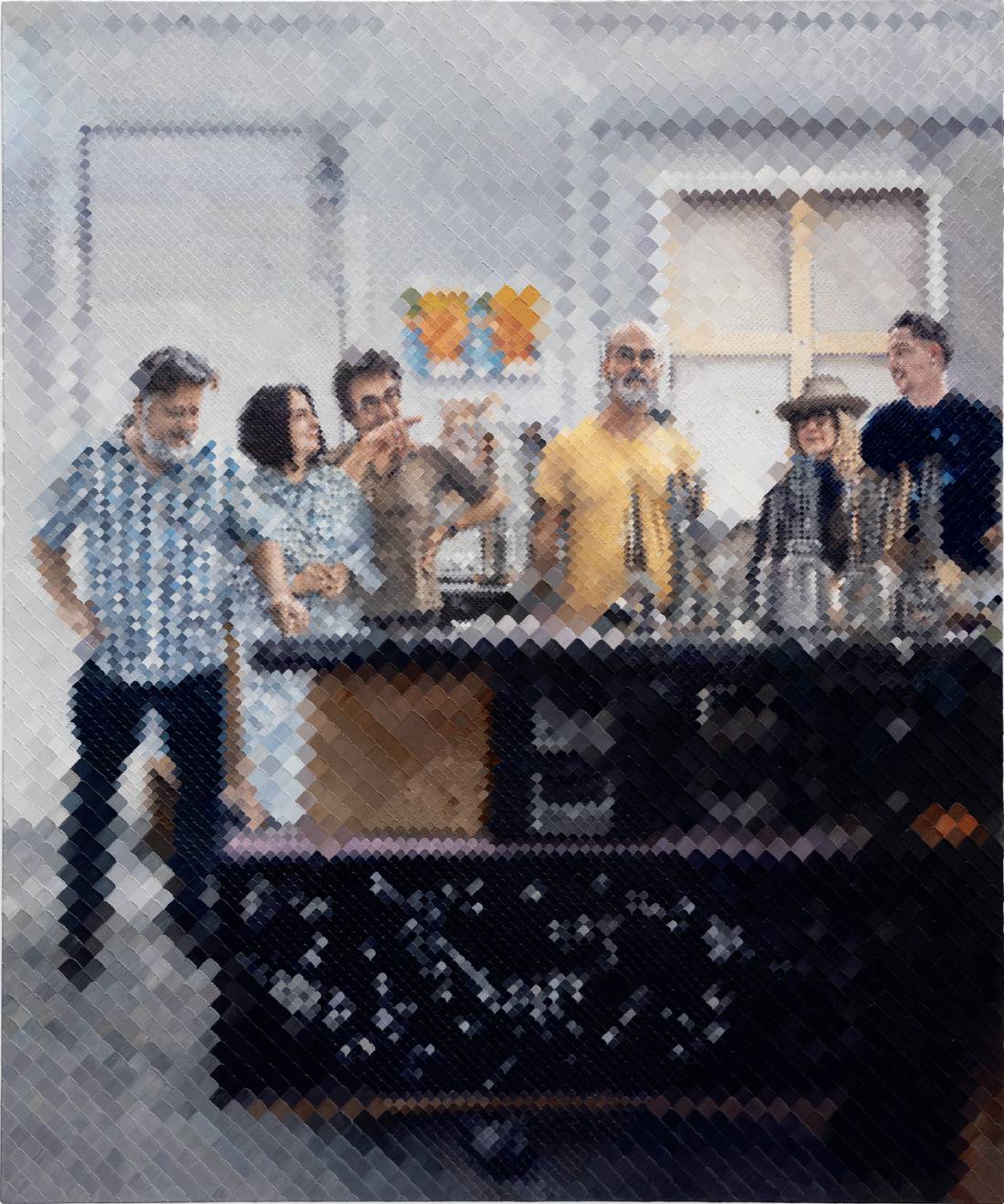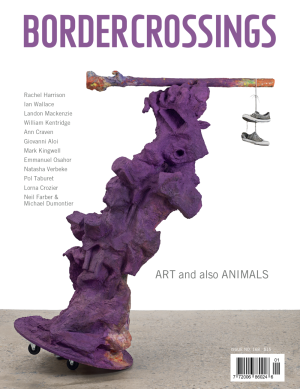Holding on to Love
The Systematic Portraits of Stephen Andrews
In 1855 Gustave Courbet finished The Painter’s Studio, an oil painting on canvas that was almost 12 feet high and 20 feet long. The subtitle is A Real Allegory Summing Up Seven Years of My Life as an Artist. Courbet painted it quickly because he wanted to include it in the Exposition universelle at the Paris World’s Fair that year; as a result, he didn’t finish the background, which he planned to be shown as a salon-style hanging of many of his other paintings.
In 2024 Stephen Andrews finished The Artist’s Studio, after Courbet. The 6-foot-tall, 42-foot-long oil on canvas—he calls it “one painting in 12 parts”—took him almost three years to complete, and the background in many of its 12 parts is populated by portraits of his friends and fellow artists.
Andrews says that he only used the Courbet as “a springboard,” but they do share some details: at the centre of both paintings is a painter and model. For Courbet, that figure is a naked woman who has dropped her clothes on the studio floor. Instead of directing his gaze at her, Courbet paints a rendition of his beloved Loue River Valley. Andrews is also backed by a nude model, whose clothes cluster in a similar pile, but his attention is directed not at the model but at the abstraction he is building on his canvas. In the fourth part of Andrew’s studio, we can see a figure looking in from an outside garden; for him, the window is a stand-in for a landscape painting. “You don’t enter into it,” he says, “you just go out the door.”
The two painters also share a taste for a particular kind of painting. Courbet is committed to realism; for Andrews, the Fibonacci sequence creates a style of painting that inhabits a space somewhere between abstraction and representation.

The Artist’s Studio, after Courbet 1 (10th), 2023, oil on canvas, 182.88 × 101.6 centimetres. Photo: LF Documentation. All images courtesy the artist and Paul Petro Contemporary Art, Toronto.
Courbet’s boast was that “the whole world came to be painted at my studio,” and Andrews could say the same thing. His world is comprised of individuals who are part of this country’s artistic community, as well as some visitors from New York. The people in The Artist’s Studio include painters Pierre Dorion, Paul P, Kent Monkman, Wanda Koop, Glenn Ligon, Zachari Logan, Andy Fabo, Alex Bierk, Christine Davis, Shaan Syed and Shelagh Keeley; writers and actors Naomi Klein, Avi Lewis, Gregg Bordowitz and Arsinée Khanjian; filmmakers Atom Egoyan, Sarah Polley and John Greyson; critics and curators Wanda Nanibush, Bojana Stantic, Douglas Crimp and Jarrett Ernest; photographers Chris Curreri and April Hickox; dancer Jarrett Siddall and musician David Wall, among many more. All these people were visitors in Stephen’s studio (on one or more occasions), where they were photographed and, from these, portraits were painted. Those were hung on his studio walls and were repainted into The Artist’s Studio, after Courbet. A crowd of people is a subject Stephen has been painting since 1991; he calls it “this idea about making pictures of communities.”
The overall feeling that emerges from the numerous repainted pictures in the 12 parts of The Artist’s Studio, after Courbet is one of care—care for the subjects being painted and care for painting itself. The painting has been acquired jointly by the National Gallery of Canada and the Art Gallery of Toronto and will first be exhibited in Ottawa on a date still to be determined. In the meantime, viewers were able to see the initial portraits that ended up being the subjects of The Artist’s Studio in an exhibition at Paul Petro’s gallery in Toronto. Called simply “Some Stories,” the exhibition is like a party where everyone had come once and then showed up again. In La Grasse Matinée, 2023, John Greyson, Stephen’s partner, is surrounded by a network of connected white and grey shapes that make up the pillows and bedclothes in which he is sleeping. The painting changes from a pattern of abstract marks into a surface redolent of intimacy and protection. It is a world of luxuriant, close looking. This single painting is an emblem for Stephen Andrews’s overall project. The act of painting becomes a declaration of loving.
The following interview was conducted by phone to Toronto on February 18, 2025.
BORDER CROSSINGS: When we first talked about The Artist’s Studio, after Courbet (2021–2023), you unaffectionately called it your big, stupid painting. Why?
STEPHEN ANDREWS: I’m one of those artists who works all the time. I get to do what I want and I decided I wanted to do this painting of my studio. I knew it was going to be big, but I had no idea how big. I thought, what am I doing? Who’s going to buy this? This is going to be finished and moved into storage. This is a fool’s errand. That’s why I ended up calling it my big, stupid painting.

The Artist’s Studio, after Courbet 3 (8th), 2023, oil on canvas, 182.88 × 50.8 centimetres. Photo: LF Documentation.
What was your original conception?
It was a reaction to a negative studio visit. I’ve been working on this digital stuff for decades, starting in the 1980s with “Facsimile” and after with a series called “Sonnets,” a work that reacted to the advent of the pixellated image in digital imaging. Part of it was about trying to hold on to love. When you’re grieving, chaos reigns and it’s hard to hold on to things. There’s a real fear about losing a loved one, so you create systems to organize the chaos. One system was making these number maps—like hidden photographs of the loved one—dropping grids over them and assigning numerical values to each one of the squares in the grid. The idea was that at any time in the future, you would be able to reconstitute this image exactly as it was the day you made it. It was about holding on to information and being able to get back to that place. It’s a place that actors go when they turn on the waterworks, right? There was something about feeling numbness and fearing the loss of that feeling. So I created these numerical systems with which to do that, and was making digital paintings in the late ’80s and early ’90s. Then in a virtual studio visit during COVID, people looked at these pixellated images and simply thought, Chuck Close.
Because of the CMYK system?
Yes. I’ve always had systems. The dot matrix stuff was all about systems. Part of that simply emerged out of where I was coming from. Emotions were so high during the AIDS crisis that I didn’t want to have a signature style when I was representing that material. I didn’t want this idea of authorship mapped onto other people’s grief, so by reducing the line to a pixel it was just information encoding the content. I wanted to signal a space for the grief to take place.
Was that a way of protecting yourself from the radical emotions of both loss and rage that were connected to the HIV crisis?
It was a way of trying to understand what was going on, so that you could be mentally prepared to deal with what happened when you left the house. You had to protest. You had to act out and act up. If you were completely debilitated emotionally, it was impossible to do the things that needed to be done, like taking care of people and getting into the cultural trenches. It was a device that I used for organizing my emotions and my intellect.
How did the negative studio visit connect to the painting?
It was the reductive way that people looked at things. Yes, Chuck Close was famous and people knew him, and I’m not famous, so people didn’t know my work. But I realized I had to rearrange the reading of these pieces. I had to get people to think about them in much more complex ways. So I thought, to do that, I’ll paint a picture of my studio and repaint all these portraits into the painting of the studio.
There is a recognized tradition of artists doing studio paintings—Rembrandt, Vermeer, Fantin- Latour and Matisse painted their studios—but among that range of choices you settled on Courbet’s version.
I was aware of the number of people who have painted their studios over the years, but his was the most famous and it was in some kind of dialogue with modernity. He is also one of the first artists working from photographs. I thought the painting is set up like a proscenium stage, which would’ve been the site of a spectacle back in the 1880s. Whereas spectacle happens online now; we use our cellphones, and they have super-wide lenses. We think about spectacle like cinematic space. And I was interested in the 100-some-odd years between those two modalities. From my first time going to Paris in the ’70s, the Courbet has been one of the touchstone paintings in my mind. It was the painting to use because everyone knows it. I like givens.
Was there a relationship between this painting and the mosaic commission that you’d done in Paris?
I had finished that project in 2018 and when I came home, I was looking at what was going on in the zeitgeist. I saw Instagram taking a while to load and the pixellation is there. I saw the advent of AI facial recognition technologies and the digital was there in the mosaic. Minecraft was a big game for kids and there seemed to be a return to the lo-fi. The new generation had rejected high-resolution, POV shooter games and was really into big, blocky characters and highly pixellated imaging. I was tapping into that, and I thought it was a good time to return to stuff I’d been doing in the ’90s. So I started making portraits. The piece in Paris is a large crowd, a motif I’ve been using for a long time. It was the most articulated version of the idea that a crowd is made up of individuals, but they’re anonymous and they form this larger entity outside their individual identities. They are each a small part of something larger than themselves. That idea about making pictures of communities has been central to my work since “Facsimile” (1991–1993). So I thought, rather than anonymous people, why not return to portraiture and make portraits of people I know? I thought I would start out by doing a bunch of young friends because they’re beautiful and that would be half the battle. All I would have to do is make a picture of them and the picture would be beautiful. So I did start making pictures of people coming out of the mosaic work and I also doubled back to something I had done in the ’80s and ’90s.

The Artist’s Studio, after Courbet 9 (6th), 2022, oil on canvas, 182.88 × 152.4 centimetres. Photo: LF Documentation.
You start your painting in the same place that Courbet did and that’s the panel with the artist and his model. After that you paint John Greyson, your partner. Then, how do you determine the order of the paintings?
It was quite spontaneous. I thought I would start with the centre because that seemed the most iconic part of the painting. I worked with Jarrett Siddall and I thought he’d be a perfect artist’s model because as a dancer he’s already a kind of model, so I asked him if he would pose for the nude role in the painting. I studied the painting and looked at a number of narrative elements and singled out ones that I would do my version of. They would be my actual connection to the Courbet. So there’s Paw Paw, the cat, a kid, a couple kissing, a canvas turned around, and there’s this weird hanging figure. I actually painted the centre panel twice. The first time I was working from a mock-up, but I was painting the canvas in the exact place the photograph had been taken. So this live version of what I was painting was in some discordance with the photographic mock-up from which I was working. I painted it to match what I saw in the studio and it was at a higher register, which is to say the lights were lighter. I finished the painting in the middle of the afternoon on a very sunny day and the light from the garden was shining onto the floor of the studio. As I was making my last brush stroke, I realized I had spent all my highlights in the darkest part of the studio. At that moment I recognized I had to repaint that section of the painting. I thought, if I have to paint light like that on the floor six months from now, I’m not going to be able to do it. So I repainted the centre panel at a darker register. You can see the conundrum because there’s nothing brighter than white.
Was the movement towards the light something that began to take over other of the paintings in The Artist’s Studio, after Courbet?
It was just trying to achieve verisimilitude in representing the space. The Courbet painting is quite dark and I didn’t want my painting to be dark. His painting is super-tall and mine can’t be because I don’t have a super-tall space. But I had no intention of slavishly reproducing his painting; I only used it as a springboard. Then each panel was cast in the moment. I had no grand plan about who was going to be in it. It was people in my life who happened to be in my studio when I was casting a panel. The composition of each one was done as I was about to start the panel. I didn’t think about what was coming next. I had to connect to what I had finished, but the composition of each one of the images is self-contained.
…to continue reading the interview with Stephen Andrews, order a copy of Issue 167 here, or subscribe today.

